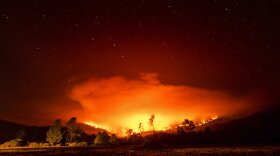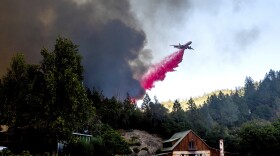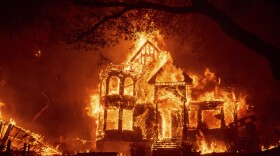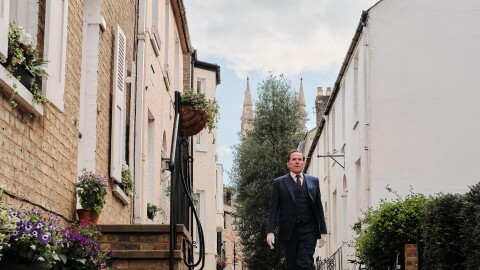FAQ
- A 3-day supply of non-perishable food & 3 gallons of water per person
- A map with at least 2 evacuation routes
- Necessary prescriptions or medications
- A change of clothes & extra eyeglasses/contact lenses
- Extra car keys, credit cards, cash, or traveler’s checks
- A first aid kit & sanitation supplies
- A flashlight & battery-powered radio with extra batteries
- Copies of important documents (birth certificates, passports, etc.)
- Pet food & water
- Always have sturdy shoes and a flashlight near your bed, ready for sudden night evacuations.
- Valuables that are easy to carry
- Family photos and irreplaceable items
- Personal computer data on hard drives and disks
- Chargers for cell phones and laptops
- Build an emergency kit: Include flashlights, extra batteries, nonperishable food (this includes packaged snacks and bottled water and juices) and a first-aid kit.
- Phones and electronics: Have a phone that doesn't depend on electricity along with a portable battery-powered radio, a wind-up or battery-operated clock and manual can opener.
- For major appliances: Turn off and unplug major appliances like your A/C and refrigerator, electronics and devices to prevent damage or unexpected starts when power is restored, but leave one light on to signal when power returns.
- For seniors: Prepare essential items like wheelchair batteries, oxygen, medications and service animal food. List medical devices with instructions.
- Create a network: Notify and alert neighbors, relatives, friends and co-workers to aid you should there be an emergency.
- Keep emergency contacts handy: Add SDG&E’s emergency phone number (800) 411-SDGE (7343) for residents and (800) 611-SDGE (7343).
To learn more about preparing for a power outage, visit this comprehensive guide from the City of San Diego: Power Outage Prep Tips or go to SDG&E resource page.
According to a 2021 study by the Scripps Institution of Oceanography, wildfire smoke is up to 10 times more harmful to humans than other types of pollution, like car exhaust, because of the abundance of PM2.5 particles.
So if you can see the haze outside your window, or if the sky looks an unusual color or the air smells like campfire, it's best to stay indoors if possible.
According to AirNow, the higher the AQI value in your area, the greater the level of air pollution and the greater the health concerns.
If you can, stay inside
If the AQI in your area is above 150, avoid going outside if you can. Avoid exercising outside or running errands that can wait until the air quality has improved. If you need to be outside, use a well-fitting N95 mask if you have one available. Because of the tiny size of those PM2.5 particles, something like a bandana or cloth face covering won't protect your lungs from the smoke.
Minimize your exposure indoors
Close all doors and windows to the outside. If your windows have cracks, use a damp towel to cover them to limit the air from outside.
If you have central air conditioning, running that should help, since air is filtered as it runs through the system. But if you have a window unit, you might not see the same benefit. Many of these types of air conditioners are designed to pull air from the outside, which could just make your room smokier.
If you have an air purifier or air filter, those are your best bet for improving indoor air quality. They can be pretty pricey, but if you're feeling crafty, try making a DIY box fan air filter for wildfire smoke — these are amazingly effective if properly taped together.
Finally, if you're hitting the road on a smoky day, press that recirculate button (it's the one that looks like arrows inside an outline of a car). That way, your car won't be pulling air from outside but will just keep recirculating the air that's already in the car, and improving the air quality the longer you drive.
Self-care for smoke-filled days
A hydrating moisturizer can help keep those smoke particles out of your pores and help with skin irritation caused by the dry air and blustery winds that often accompany wildfires.
Drinking lots of water will also help your overall well-being, since fires usually happen where the air is dry and windy, and often (but not always!) occur on hot days.
If the smell of the smoke is getting to you, try dabbing a bit of essential oil under your nose or use a strong-scented chapstick to mask the smell.
And most importantly: try to stay calm. Smoke days are stressful and an upsetting reminder of our changing climate. Anxiety will make all the effects of smoke exposure feel worse to you, so it might be helpful to remember that other communities have come through similar or worse smoke situations, and the air will eventually clear.
Read NPR Life Kit's full story here.
So if you can see the haze outside your window, or if the sky looks an unusual color or the air smells like campfire, it's best to stay indoors if possible.
According to AirNow, the higher the AQI value in your area, the greater the level of air pollution and the greater the health concerns.
If you can, stay inside
If the AQI in your area is above 150, avoid going outside if you can. Avoid exercising outside or running errands that can wait until the air quality has improved. If you need to be outside, use a well-fitting N95 mask if you have one available. Because of the tiny size of those PM2.5 particles, something like a bandana or cloth face covering won't protect your lungs from the smoke.
Minimize your exposure indoors
Close all doors and windows to the outside. If your windows have cracks, use a damp towel to cover them to limit the air from outside.
If you have central air conditioning, running that should help, since air is filtered as it runs through the system. But if you have a window unit, you might not see the same benefit. Many of these types of air conditioners are designed to pull air from the outside, which could just make your room smokier.
If you have an air purifier or air filter, those are your best bet for improving indoor air quality. They can be pretty pricey, but if you're feeling crafty, try making a DIY box fan air filter for wildfire smoke — these are amazingly effective if properly taped together.
Finally, if you're hitting the road on a smoky day, press that recirculate button (it's the one that looks like arrows inside an outline of a car). That way, your car won't be pulling air from outside but will just keep recirculating the air that's already in the car, and improving the air quality the longer you drive.
Self-care for smoke-filled days
A hydrating moisturizer can help keep those smoke particles out of your pores and help with skin irritation caused by the dry air and blustery winds that often accompany wildfires.
Drinking lots of water will also help your overall well-being, since fires usually happen where the air is dry and windy, and often (but not always!) occur on hot days.
If the smell of the smoke is getting to you, try dabbing a bit of essential oil under your nose or use a strong-scented chapstick to mask the smell.
And most importantly: try to stay calm. Smoke days are stressful and an upsetting reminder of our changing climate. Anxiety will make all the effects of smoke exposure feel worse to you, so it might be helpful to remember that other communities have come through similar or worse smoke situations, and the air will eventually clear.
Read NPR Life Kit's full story here.
Wireless Emergency Alerts (WEA) can keep you updated, but knowing how to control these notifications is crucial. Below are instructions to help you turn your WEA alerts on or off for iOS, Android and Google Pixel devices.
For iOS Devices (iPhone)
According to Apple Support, follow these steps to manage government alerts on iOS:- Open the Settings app.
- Scroll down and tap Notifications.
- Scroll to the bottom to find Government alerts.
- Use the toggles to turn AMBER alerts, Emergency alerts, Public safety alerts, and Test alerts on or off.
For Android and Google Pixel devices
According to Google Support, here’s how to manage Wireless Emergency Alerts on Android. You can find the information by scrolling down and selecting "Wireless Emergency Alerts & Emergency Alert System" under "Find out about earthquakes in your area."- Open the Settings app.
- Scroll down and tap Safety & emergency.
- Tap Wireless emergency alerts.
- Toggle alerts such as AMBER Alerts, Severe weather alerts, and Emergency alerts on or off.
As of 11:40 a.m. Friday, the Border 2 Fire had burned 5,389 acres and was 10% contained, according to CalFire.
-
California has already shattered records for the amount of land scorched in a single year. A year earlier, at least 37 people were killed, and officials say this year's blazes eclipse anything they've seen.
-
California is poised to hit a fearsome milestone: 4 million acres burned this year by wildfires that have killed 30 people and incinerated hundreds of homes in what is already the worst fire season on record.
-
A brush fire at Camp Pendleton on Wednesday afternoon is forcing base officials to implement a preliminary evacuation.
-
Flames devoured swaths of brush and trees in Northern California on Wednesday amid unseasonably hot and dry weather.
-
Santa Ana winds will sweep through parts of San Diego County Tuesday as temperatures heat up and humidity remains low, significantly raising the risk of wildfires throughout the region, according to the National Weather Service.
-
California firefighters battled destructive new wildfires in wine country north of San Francisco Monday as strong winds fanned flames in the already badly scorched state.
-
KPBS Midday EditionSanta Ana winds will sweep through parts of San Diego County Monday as temperatures heat up amid low humidity, significantly raising the risk of wildfires throughout the region, according to the National Weather Service.
-
The nation's largest electric utility has temporarily shut off power to thousands of Northern California residents to prevent wildfires sparked by electrical equipment as the state braces for potentially strong winds and extreme fire weather conditions.
-
Fire-weary California is preparing for a new siege of hot, dry weather with potentially strong winds that could ignite new blazes.
-
KPBS Midday EditionMisinformation is continuing to spread on social media about the wildfires in California, Oregon and Washington.
RELATED STORIES
Sign up for our newsletters!
Keep up with all the latest news, arts and culture, and TV highlights from KPBS.
- North County housing project clears big hurdle despite fire fears
- Algunos agricultores de Florida reducen sus cultivos porque el temor a deportaciones aleja a trabajadores
- Arrest near a South Bay high school is latest in a string of immigration enforcements close to schools
- Hawaii's Kilauea volcano erupts again and shoots lava for 31st time since December
- San Diego Police Department agrees to improve on the 'complaint process' for officers


























